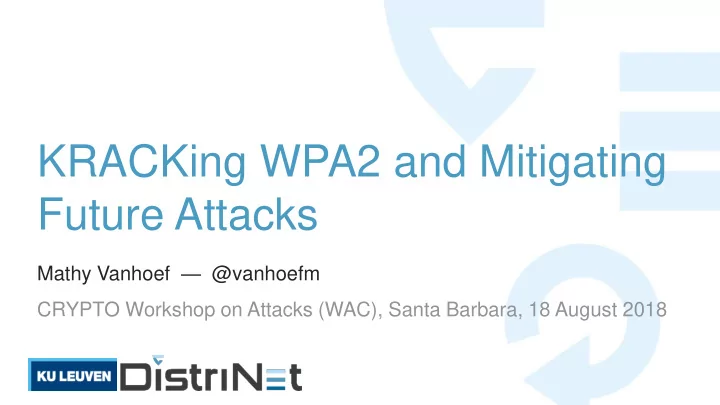

KRACKing WPA2 and Mitigating Future Attacks Mathy Vanhoef — @vanhoefm CRYPTO Workshop on Attacks (WAC), Santa Barbara, 18 August 2018
Overview Key reinstalls in 4-way handshake Misconceptions Practical impact Channel validation 2
Overview Key reinstalls in 4-way handshake Misconceptions Practical impact Channel validation 3
The 4-way handshake Used to connect to any protected Wi-Fi network › Provides mutual authentication › Negotiates fresh PTK: pairwise transient key Appeared to be secure: › No attacks in over a decade (apart from password guessing) › Proven that negotiated key (PTK) is secret › Encryption protocol also proven secure 4
4-way handshake (simplified) 5
4-way handshake (simplified) 6
4-way handshake (simplified) PTK = Combine(shared secret, ANonce, SNonce) 7
4-way handshake (simplified) Attack isn’t about ANonce or SNonce reuse PTK = Combine(shared secret, ANonce, SNonce) 8
4-way handshake (simplified) 9
4-way handshake (simplified) 10
4-way handshake (simplified) PTK is installed 11
4-way handshake (simplified) 12
Frame encryption (simplified) Nonce Plaintext data (packet number) Packet key PTK Mix (session key) Nonce Nonce reuse implies keystream reuse (in all WPA2 ciphers) 13
4-way handshake (simplified) Installing PTK initializes nonce to zero 14
Reinstallation Attack Channel 1 Channel 6 15
Reinstallation Attack 16
Reinstallation Attack 17
Reinstallation Attack Block Msg4 18
Reinstallation Attack 19
Reinstallation Attack In practice Msg4 is sent encrypted 20
Reinstallation Attack Key reinstallation! nonce is reset 21
Reinstallation Attack Same nonce is used! 22
Reinstallation Attack Keystream Decrypted! 23
Key Reinstallation Attack Other Wi- Fi handshakes also vulnerable (CCS’17) › Group key, FT, and PeerKey handshake Lesser- known handshakes also vulnerable (CCS’18) › TDLS, FILS, and WNM handshake 24
Overview Key reinstalls in 4-way handshake Misconceptions Practical impact Channel validation 25
General impact Transmit nonce reset Decrypt frames sent by victim Receive replay counter reset Replay frames towards victim 26
Cipher suite specific AES-CCMP: No practical frame forging attacks WPA-TKIP: › Recover Message Integrity Check key from plaintext › Forge/inject frames sent by the device under attack GCMP (WiGig): › Recover GHASH authentication key from nonce reuse › Forge/inject frames in both directions 27
Handshake specific Group key handshake: › Client is attacked (only AP sends real broadcast frames) › Can only replay broadcast frames to client 4-way handshake: client is attacked replay/decrypt/forge FT handshake (fast roaming = 802.11r): › Access Point is attacked replay/decrypt/forge › No MitM required, can keep causing nonce resets 28
Implementation specific iOS 10 and Windows: 4-way handshake not affected › Cannot decrypt unicast traffic (nor replay/decrypt) › But group key handshake is affected (replay broadcast) › Note: iOS 11 does have vulnerable 4-way handshake wpa_supplicant 2.4+ › Client used on Linux and Android 6.0+ › On retransmitted msg3 will install all-zero key 29
30
Android (victim) 31
32
33
34
35
Now trivial to intercept and manipulate client traffic 36
Is your device (still) affected? github.com/vanhoefm/krackattacks-scripts › Tests clients and APs › Works on Kali Linux Remember to: › Disable hardware encryption › Use a supported Wi-Fi dongle! 37
Countermeasures M any clients won’t get updates… AP can prevent (most) attacks on clients! › Don’t retransmit message 3/4 › Don’t retransmit group message 1/2 However: › Impact on reliability unclear › Clients still vulnerable when connected to unmodified APs 38
Overview Key reinstalls in 4-way handshake Misconceptions Practical impact Channel validation 39
Misconceptions I Updating only the client or AP is sufficient › Both vulnerable clients & vulnerable APs must apply patches Need to be close to network and victim › Can use special antenna from afar No useful data is transmitted after handshake › Trigger new handshakes during TCP connection 40
Misconceptions II Obtaining channel-based MitM is hard › Can use channel switch announcements Using (AES-)CCMP mitigates the attack › Still allows decryption & replay of frames Enterprise networks (802.1x) aren’t affected › Also use 4-way handshake & are affected Image from “ KRACK: Your Wi-Fi is no longer secure” by Kaspersky 41
Overview Key reinstalls in 4-way handshake Misconceptions Practical impact Channel validation 42
Background: new attacks require MitM Traffic Analysis › Capture all encrypted frames › Block certain encrypted frames Attacking broadcast WPA-TKIP › Block MIC failures › Modify encrypted frames 43
Background: new attacks require MitM Exploit implementation bugs › Block certain handshake messages › E.g. bugs in 4-way handshake Other attack scenarios › See WiSec’18 paper [VBDOP18] › E.g. modify advertised capabilities 44
Observed threat model › Attacker manipulates channel and bandwidth › Exclude low-layer attacks (e.g. beamforming) › Exclude relay attacks (e.g. AP and client out of range) Want to make attacks harder, not impossible ≈ stack canaries. Solution: verify operating channel when connecting 45
Verifying the current operating channel Simple, just verify channel number element? › Say hello to the 802.11 standard › HT element defines optional 40 MHz bandwidth › VHT element defines more bandwidths › And so on … › Non-trivial to unambiguously encode channel We introduce the OCI element to encode a channel 46
Problem: Channel Switch Announcements (CSAs) Unauthenticated CSAs › Need to verify securely Authenticated CSAs › May not arrive verify reception Solution: verify CSA using SA query 47
Limitations Other (partial) MitM attacks still possible: › Adversary can act as repeater › Physical-layer tricks (e.g. beamforming) So why use this defense? › Remaining attacks are harder & not always possible › Straightforward implementation 48
Standardization & implementation Part of the upcoming 802.11 standard Implementation is being pushed upstream: github.com/vanhoefm/hostap-channel-validation 49
Conclusion › Flaw is in WPA2 standard › Proven correct but is insecure! › Update all clients & check Aps › New defense: channel validation 50
Thank you! Questions? krackattacks.com
Recommend
More recommend